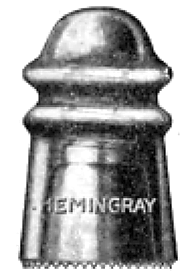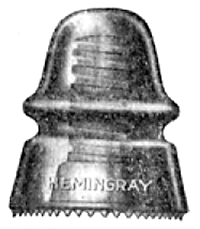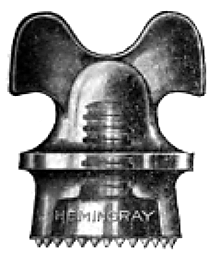[Trade Journal]
Publication: Exporters Review
New York, NY, United States
vol. 15, no. 2, p. 33, col. 1-2
American Goods Suitable for the Export Trade.
PROPERLY ANNEALED GLASS INSULATORS
THE extension of power, telegraph and telephone lines throughout the world creates a steady demand for glass insulators made with a view to withstand high or low tension currents, climatic conditions, etc. Not every glass insulator is fitted for certain kinds of work, and much depends on how it is made. For years the name "Hemingray" has been synonymous, not only with “glass insulators,” but with "good glass insulators.” The Hemingray insulators manufactured by the Hemingray Glass Company, Covington, Ky., have been and are good insulators, because they have been and are of good design and material subjected to proper processes of manufacturing, including especially perfect annealing.
 |
In a glass insulator, “good design" means more than proper lines electrically — it means a design which so distributes the material that good annealing is possible. Given such a design and a proper proportioning of material (including not too much cullet), it is possible to obtain, and the Hemingray Glass Company does produce, a completed insulator every part of which is thoroughly annealed. Thorough annealing is of supreme importance in a glass insulator, and faults which have been found against glass as a material for line insulators have been due to the past practice of some manufacturers who not only have used improper annealing methods, or material which was practically incapable of being properly annealed, but also have accepted for manufacture certain designs of insulators which so distributed the material as to make proper annealing practically impossible, no matter what materials or methods were used. The Hemingray Glass Company has followed as one of its first principles the practice of not accepting for manufacture any design which their 65 years of experience would indicate could not be properly and perfectly annealed. This is the prime reason for the uniform success of the Hemingray insulator; the reason for its superior mechanical quality of strength and capabilities to withstand the shocks of sudden blows or rapid and extreme temperature changes; the reason for its remarkable electrical qualities as a high voltage insulator.
 |
The importance of annealing on the electrical properties of glass should be thoroughly understood to be appreciated. The term “insulator” is technically only a relative one and means that the specific resistance to the passage of electric current is very high. No substance is a perfect insulator, in the sense that its specific resistance is infinite. Therefore, through any “insulator” which is interposed in an electric circuit, a certain current is constantly flowing. This electric current may be almost infinitesimal under low voltages, but with a high enough voltage may become sufficiently great to moderately warm the insulator. Further, it has been proven by experiment that annealing glass greatly increases its specific resistance, or, in other words, improves its qualities as an insulator. If, then, an unevenly annealed glass insulator be subjected to high voltage, the leakage currents will tend to follow the paths of least resistance (or imperfect annealing), thus heating those parts more than the others and increasing the mechanical strains. Besides the leakage currents through the body of an insulator, there are also such currents over the surface, due to the presence of moisture or the surface not being perfectly clean. These currents also tend to locally heat some portions of the insulator more than others, and thereby set up additional mechanical strains. A properly annealed glass insulator may successfully withstand strains which would crack or shatter an improperly or unevenly annealed insulator. A very severe strain may also be imposed upon the glass insulator if it be quickly cooled by a sudden shower of water in the first dash of a rain storm. That the Hemingray insulator is perfectly capable of withstanding such shocks is amply evidenced by the results of hundreds of tests. In past years there has been a tendency among glass insulator manufacturers to list their insulators purely as a glass product, showing designs, dimensions and weights, but giving no electrical specifications whatever.
 |
The Hemingray Glass Company believe that this attitude is a wrong one, and that their customers have a right to be informed as to the electrical tests which have been and may be passed by the various listed insulators. To this end a large number of electrical tests have been made by Professor Albert S. Richey and Mr. Francis J. Adams of the Worcester (Mass) Polytechnic Institute, which are set forth in an interesting booklet issued by the company. This booklet, as well as other literature, price lists, etc., will be sent on request to export buyers, importers abroad, railroad and power companies, etc.
